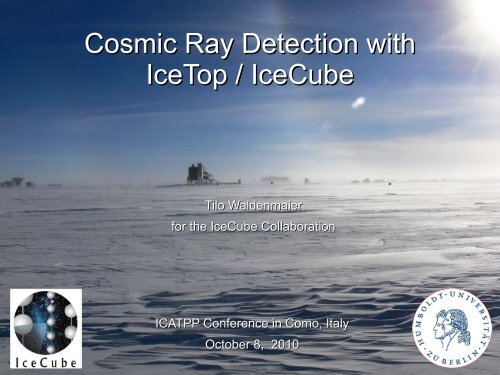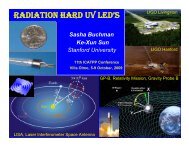Cosmic Ray Detection with IceTop / IceCube - Villa Olmo
Cosmic Ray Detection with IceTop / IceCube - Villa Olmo
Cosmic Ray Detection with IceTop / IceCube - Villa Olmo
You also want an ePaper? Increase the reach of your titles
YUMPU automatically turns print PDFs into web optimized ePapers that Google loves.
<strong>Cosmic</strong> <strong>Ray</strong> <strong>Detection</strong> <strong>with</strong><br />
<strong>IceTop</strong> / <strong>IceCube</strong><br />
Tilo Waldenmaier<br />
for the <strong>IceCube</strong> Collaboration<br />
ICATPP Conference in Como, Italy<br />
October 8, 2010
Outline<br />
<br />
<br />
<br />
The <strong>IceCube</strong> and <strong>IceTop</strong> detectors<br />
Air Shower Reconstruction <strong>with</strong> <strong>IceTop</strong><br />
<strong>Cosmic</strong> <strong>Ray</strong> Physics <strong>with</strong> <strong>IceCube</strong><br />
► All Particle Energy Spectrum <strong>with</strong> <strong>IceTop</strong><br />
► Muon Identification <strong>with</strong> <strong>IceTop</strong><br />
► <strong>IceTop</strong>-<strong>IceCube</strong> coincident Events<br />
<br />
Summary<br />
2
<strong>IceCube</strong> Site<br />
Amundsen-Scott Station<br />
Drill Camp 09/10<br />
<strong>IceCube</strong> Lab<br />
Geogr. South Pole<br />
Martin A. Pomerantz<br />
Observatory (MAPO)<br />
South Pole<br />
Telescope (SPT)<br />
3
The <strong>IceCube</strong> Detector<br />
<strong>IceCube</strong> Lab<br />
<strong>IceTop</strong><br />
81 stations consisting of 2 Č-detectors each<br />
Instrumented area: 1 km 2<br />
Deployment Years<br />
<strong>IceCube</strong> Array<br />
86 strings including 60 DOMs<br />
Instrumented volume: 1 km 3<br />
DeepCore<br />
6 additional low energy strings<br />
IC01: 2004 / 2005<br />
IC09: 2005 / 2006<br />
IC22: 2006 / 2007<br />
IC40: 2007 / 2008<br />
IC59: 2008 / 2009<br />
IC79: 2009 / 2010<br />
IC86: 2010 / 2011<br />
Digital Optical Module<br />
4
Digital Optical Module<br />
Design Requirements:<br />
Minimal signal loss<br />
Minimal number of channels (cables)<br />
Minimal data traffic<br />
<br />
<br />
PMT <strong>with</strong> integrated HV-converter<br />
Onboard Digitalisation<br />
►<br />
ATWD, 128 Samples in 422 ns<br />
► FADC, 256 samples in 6.4 µs<br />
<br />
<br />
<br />
Local Coincidence <strong>with</strong> neighbors<br />
(noise suppression)<br />
Onboard calibration and tests<br />
Autonomous operation<br />
32 cm<br />
5
<strong>IceTop</strong> Layout<br />
String 43<br />
String 35<br />
125 m<br />
Tank 35A<br />
~ 25 m<br />
10 m<br />
Tank 35B<br />
6
<strong>IceTop</strong> Station<br />
7
<strong>IceTop</strong> Station<br />
LG DOM<br />
HG DOM<br />
Perlite<br />
0.9 m<br />
0.57 m<br />
ICE<br />
diffuse reflective coating<br />
1.86 m<br />
8
Local Coincidence and Trigger<br />
Tank A<br />
Tank B<br />
High Gain:<br />
► High Voltage: ~ 1250 V<br />
► Gain: 5E6<br />
61<br />
notifies<br />
63<br />
► Disc. Thr.: ~ 20 PE<br />
► Disc. Rate: ~ 1600 Hz<br />
► LC-Rate: ~ 20 Hz<br />
Low Gain:<br />
62<br />
64<br />
► High Voltage: ~ 750 V<br />
► Gain: 1E5<br />
► Disc. Thr.: ~ 200 PE<br />
► Disc. Rate: 30-100 Hz<br />
LC-Window: ±1µs<br />
► LC-Rate: ~ 7 Hz<br />
Simple Majority Trigger condition:<br />
6 LC-hits (at least 2 stations) <strong>with</strong>in 5 µs (readout window: ±10 µs, IC59-Rate: 22 Hz)<br />
9
Muon Calibration<br />
Calibrating the tank signals in Vertical Equivalent Muons<br />
HG-LG crossover<br />
10
Tank Signal Distribution<br />
HG-LG transition<br />
Few DOMs (2-3) <strong>with</strong><br />
low cross-over values<br />
Dynamic range: 4,5 orders of magnitude<br />
~ 20 VEM (~2500 PE)<br />
11
Air Shower Reconstruction<br />
<strong>with</strong> <strong>IceTop</strong><br />
12
Lateral Distribution<br />
Energy: ~ 10 PeV<br />
S 125<br />
125 m<br />
Double Logarithmic Parabola:<br />
E.m. shower size at R=125 m<br />
(Energy estimator)<br />
Slope ≈ 3 at R=125 m<br />
(slightly composition dependent)<br />
ϰ = 0.303<br />
(constant for hadronic primaries)<br />
13
Shower Front Curvature<br />
Zenith: ~ 26.3 deg<br />
Approximately constant shape of shower front for hadronic primaries:<br />
May slightly vary <strong>with</strong> energy and primary type → ongoing work<br />
14
Fit Procedure and Resolutions<br />
<br />
Negative Log-Likelihood minimization including charge, timing and silent stations<br />
Seven parameters: x, y, θ, φ, S 125<br />
, β, t 0<br />
<br />
Minimum of 5 stations (10 tanks) required.<br />
(<strong>IceTop</strong>-26)<br />
(<strong>IceTop</strong>-26)<br />
15
Energy Range & Physics Goals<br />
Energy Threshold (# Stations ≥ 5)<br />
90%<br />
3.2 PeV (Iron)<br />
1.8 PeV (Proton)<br />
<strong>IceTop</strong><br />
Threshold < 1 PeV for # Stations ≥ 3 (less accurate)<br />
Main Physics Motivations:<br />
<strong>Cosmic</strong> ray energy spectrum between 1 PeV and 1 EeV<br />
<strong>Cosmic</strong> ray composition<br />
(Search for transition between galactic and extra-galactic cosmic rays)<br />
Test of hadronic interaction models<br />
16
<strong>Cosmic</strong> <strong>Ray</strong> Physics <strong>with</strong> <strong>IceCube</strong><br />
17
Air Shower Observables<br />
Primary energy: 1 – 100 PeV<br />
Electromagnetic particles<br />
O(10) – O(100) MeV<br />
<strong>IceTop</strong><br />
Low energy muons<br />
O(1) – O(10) GeV<br />
High energy muons (> 500 GeV)<br />
# Muons: O(10) - (1000)<br />
Data<br />
<strong>IceCube</strong><br />
Muon Estimator<br />
Iron<br />
Protons<br />
<strong>IceTop</strong> Energy<br />
18
<strong>IceTop</strong> Energy Reconstruction<br />
Protons<br />
Differential Flux Spectra in S 125<br />
Energy conversion function:<br />
Depend on zenith band and primary composition<br />
→ Reconstruction of primary energy spectra depends on a priori composition assumption<br />
19
Reconstruction Performance<br />
(<strong>IceTop</strong>-26)<br />
Energy Resolution (sigma)<br />
Reconstruction Bias (offset)<br />
Reconstruction Efficiency (area)<br />
20
Response Matrix<br />
<br />
<br />
One matrix for each zenith band and composition model<br />
Includes all effects (atmosphere, detector response, …)<br />
Smoothed Response Matrix<br />
→ Unfolding of primary energy spectra<br />
21
Unfolded Energy Spectra<br />
(<strong>IceTop</strong>-26)<br />
Proton assumption<br />
Iron assumption<br />
preliminary<br />
preliminary<br />
Two component assumption<br />
<br />
<br />
<br />
Isotropic flux condition requires<br />
consistent spectra in all zenith bands<br />
Best agreement in all three zenith<br />
bands for p/Fe two component model<br />
Works also for other reasonable<br />
composition models (e.g. poly-gonato)<br />
preliminary<br />
Not a composition measurement but<br />
a consistency check!<br />
22
Muon Identification <strong>with</strong> <strong>IceTop</strong><br />
Only histogram signal of tanks where the expected signal S exp<br />
is below threshold (< 1 VEM)<br />
(Effective cut on radial distance → only outer stations)<br />
Mostly low energy muons at the outer region of a shower<br />
Muon peak appears at ~1 VEM → Peak area (# muons) sensitive to primary composition<br />
23
Muon Identification <strong>with</strong> <strong>IceTop</strong> (cont.)<br />
S exp<br />
< 0.125 VEM<br />
Iron<br />
Data<br />
Proton<br />
preliminary<br />
<br />
<br />
<br />
Reasonable agreement between data and Monte Carlo<br />
Peak area in data between proton and iron (good, but peak shape seems to be wider)<br />
Ongoing work: Improvement of simulation, Peak area as a function of energy<br />
24
<strong>IceTop</strong>−<strong>IceCube</strong> Coincident Events<br />
<strong>IceTop</strong><br />
(<strong>IceCube</strong>)<br />
<strong>IceCube</strong><br />
courtesy R. Engel<br />
(<strong>IceTop</strong>)<br />
<br />
<br />
Only muons <strong>with</strong> E > 300 GeV reach <strong>IceCube</strong><br />
High energy muons from very first interactions<br />
→ good sensitivity to composition<br />
25
K 70<br />
Muon Estimator<br />
surface<br />
<br />
Cannot directly measure number of muons in a<br />
bundle<br />
X<br />
<br />
Estimation of muon number by fitting an<br />
appropriate light emission/propagation model<br />
d<br />
Detectable charge at point (X,d):<br />
λ eff<br />
: Effective scattering/absorption length → Ice model<br />
Muon estimator:<br />
Center of <strong>IceCube</strong><br />
Distance to bundle axis<br />
26
<strong>Cosmic</strong> <strong>Ray</strong> Composition<br />
Proton fraction (<strong>IceCube</strong>-40)<br />
100 % Proton 100 % Iron<br />
<br />
<br />
<br />
<br />
Data consistent <strong>with</strong> mixed<br />
composition<br />
Tendency to heavier elements<br />
for log(E/GeV) > 6.8<br />
Main systematics:<br />
►<br />
►<br />
►<br />
►<br />
Hadronic interaction model<br />
Ice model<br />
Snow accumulation on tanks<br />
Atmospheric variations<br />
Quantitative evaluation by<br />
►<br />
Neural Network → <br />
►<br />
(2D Unfolding)<br />
27
Neural Network Analysis<br />
<br />
<br />
<br />
Tight and composition independent energy resolution<br />
Interpretation of NN mass output as linear combination of<br />
“pure” elements (p, He/O, Fe) → elemental fractions<br />
Calculation of by:<br />
E = 1-10 PeV<br />
log 10<br />
(E/GeV) = 6.6-6.8<br />
Toy Simulation p+Fe only!<br />
NN Output: Type<br />
28
Summary<br />
90% of <strong>IceCube</strong> are installed and running (completion in 2011).<br />
<br />
<br />
<strong>IceTop</strong> and <strong>IceCube</strong> offer various complementary possibilities for<br />
determining the cosmic ray energy spectrum and composition in<br />
the energy range between 1 PeV and 1 EeV.<br />
Requiring consistent results between all analyses will reduce<br />
systematic uncertainties and can be used for testing hadronic<br />
interaction models.<br />
First results are coming soon ...<br />
29




